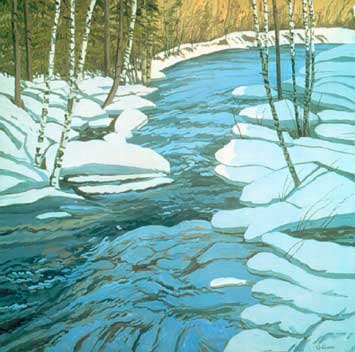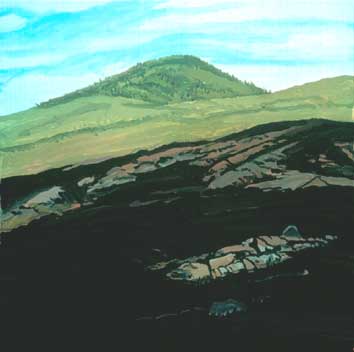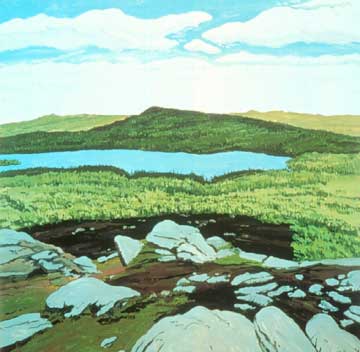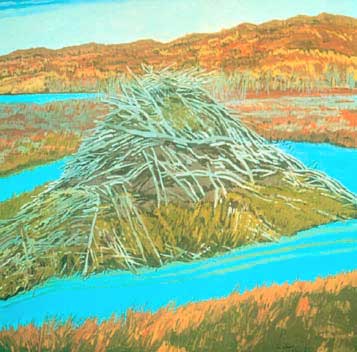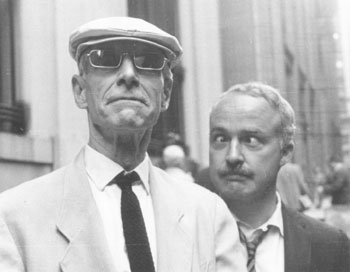|
Q. Why do you mix your colors from bright blues and cadmiums reds and yellows since earth and Mars colors or oxide of chromium green would be closer to colors you have in your paintings?
A. I’ve eliminated all of the earth colors from my palette. I’ve eliminated them because there is a luminosity I’m after, that I can never find in those colors. I prefer to mix something which is their equivalent which is, for me, more luminous. If I want a green earth, I’m much more inclined to make that from a manganese blue and black and cadmium yellow with a touch of red, which creates a color that is its equivalent but, for me, livelier.
Q. Do you think some 19th century American landscapists were as sensitive to color in painting and the transposition from nature to the painting?
A. No.
Q. Or European ones?
A. No. Not really. Some in Europe.
Q. Courbet seems to be an example.
A. Yes. Courbet is marvelous in the way he saw those greens and all the variants, but the color, my use of color, is really predicated on the painting of the last 50 years and not 19th century painting at all.
Q. Who would you name? Anybody that gave you suggestions by his painting? That you then changed into your own?
A. That’s a complicated question. Albers, certainly. Mondrian, too, for those constellations of colors that are separate. Yes, I learned a lot from Mondrian. Bonnard, a great deal. Monet, obviously. In the late Monet, it doesn’t’ seem as though he is looking anymore. He is putting colors together and fabricating an image.
Q. Among the young Americans, I am thinking of Pollock, was his color of interest to you?
A. Not, particularly. The thing about Pollock that excited me, and still does, is accepting the physical fact of the canvas. Acknowledging the physical fact of the canvas. Acknowledging the fact of the painting. Pollock’s aggression about the fact of the painting and so on. I like that. I feel I come much more from that than I do from anywhere else.
Q. De Kooning ...
A. Yes, de Kooning. Because there is the development of the image and at the same time an insistence on the fact of the painting. And it’s that I would like to have. I want to develop a much more, whatever you want to call it, precise image. But really, my interest in painting lies in the fact of the painting. And I think that’s why sometimes people find the big paintings uncomfortable. Because they, in fact, perceive the space, sense it, and at the same time are repelled by the aggression of the painting, of the pigment, of the fact of the picture, its size. And it’s the same in the small ones. It’s absolutely the same in the small paintings, it’s just that it is less aggressive, easier to digest there. People who object to my painting, and they do, object very often to the aggression of the fact of the picture. They find the canvas, that surface, what happens on there, too much for them. They would really prefer to drift off into Bierstadt or someone, Corot, or something like that where you can really just enter into it and leave. With mine, there is the resistance of the surface of the painting. The fact of the painting is always in the way.
Q. But large picture, if there is much going on in them, are hard to accept. It takes longer.
A. It does take a while longer. Yes. But, you know, if you look at the 19th century American luminous painters, as they are now called, Church, in particular, or Bierstadt. If you look at the construction of the larger pictures, there is a very careful overlapping construction which takes you ‘in’ to this thing, in, in, in, in, to the painting. And a denial of the surface of the painting by its construction. It still relates back to that Renaissance idea of denying the surface, divine perspective, etc., that still pervades those paintings and between the late 19th century and now comes this, what is for me one of the great ideas of 20th century painting, and that is the fact of the painting again. The assertion of the ...
Q. The cut of the edge?
A. Right. And the surface of the picture is a fact on which you paint. The maintenance of that is very exciting to me, but I also want the other thing, so you have that conflicted image. What you hope for is something that virtually oscillates, where you go on in and there’s a surface and you go in and there’s the surface. And that, I think, is difficult to look at.
Q. And that’s what you would like to do?
A. Yes. Have my cake and eat it too.
Q. Yes. That’s what art’s about.
A. Right.
Q. When did you first want to become a painter?
A. Shortly after I no longer wanted to be a fireman or a pilot or an engineer.
Q. Is that 12 or 18?
A. In my case, it was 28 (laughter). When I was very small.
Q. Where did you study and who were your teachers?
A. I studied at the Philadelphia Museum School and no one would know the teachers I studied with there, with the exception of Emerton Heitland, a traditional watercolorist. And then I went to Yale and studied with Albers, Marca-Relli, Brooks and Diller.
Q. Did you like any of them particularly?
A. Yes, I particularly liked Jim Brooks, who had a marvelous capacity for looking at any kind of painting and being able to see it in terms of the way it was put together. Diller was a very interesting guy to study with. I remember an occasion when he came to a figure and cut out a little rectangle and put it on the forehead of the figure and said re-establish the picture plane. So he taught that straight De Stijl stuff and was relentless. And of course, Albers. I must say he was an absolutely incredibly good teacher and most of the teaching and conversation and so on was outside of art. It had to do with color and how colors interacted, the optics of color. That was very exciting stuff for me. In a curious way you learned a lot about the mechanics of painting, even when you weren’t painting ... studying with him. Finally, I think he was interested in poetry like everyone else and that was the bottom line, but there was a great deal to be learned from him. He was a very good teacher.
Q. You’ve lived in New Haven and Philadelphia, but not in New York. Why do you live in Lincolnville?
|

